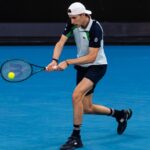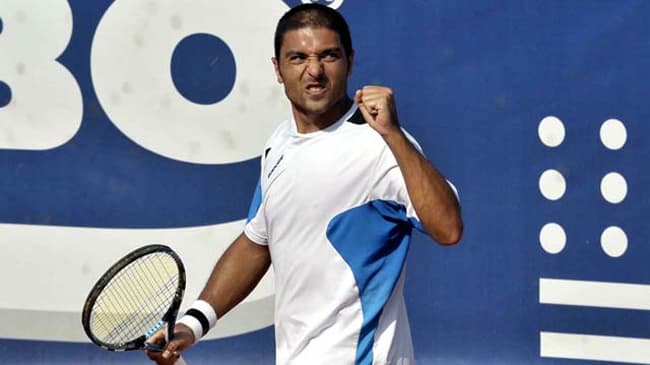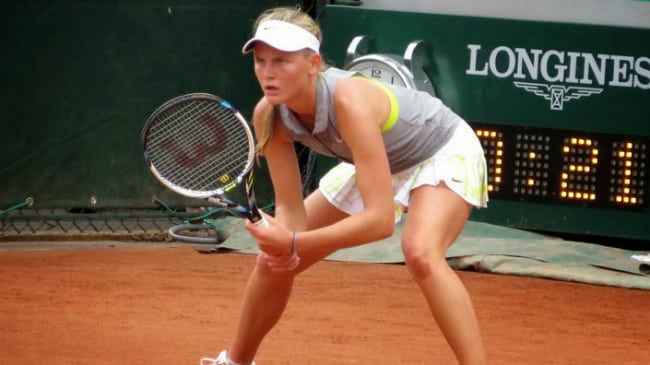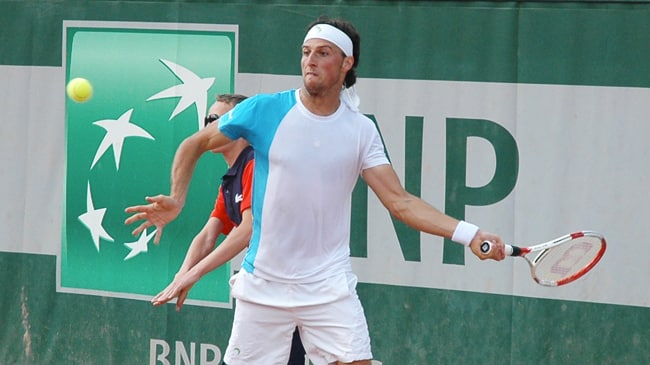[the_ad id=”46623″]
by Michele Galoppini and Giulio Gasparin
The WTA 2017 season has officially ended, after the brilliant wins of Caroline Wozniacki and Julia Goerges, respectively in WTA Finals and in WTA Elite Trophy. But it is already time to look at the future and to the next, already incoming, season. One of the best chances to talk about the future has been with Steve Simon, WTA CEO, who recently spoke with SpazioTennis and the media during the final stages of WTA Linz. Many have been the important topics, from a new and rearranged WTA Calendar from 2019 to a brand new Elite Trophy, from an early and longer European swing to a possible ‘WTA Next Gen Finals’.
WTA has had a quite exciting year, with many number ones, surprising slam winners…
2017 was definitely a rollercoaster and for this reason it was a very exciting year. It represented a transition, a new start but also showed the depth of female tennis. After Angelique Kerber, we had three new world number 1, the rankings for the top10 is so tight right now, and players who qualified for WTA finals in Singapore has an average age of 24 year-old, taking out the legendary Venus Williams who is 37 who showed how to defy age. Future is bright for WTA.
About future, this is the penultimate year for Singapore, and there are many cities who showed interest for next season, including European candidates. What do you think about this, considering the idea of WTA to be more and more global?
We are excited about it cause everyone in Singapore is still very interested in WTA finals and they are also one candidate for next editions of WTA finals. And that’s great. But the global interest results at the moment in 6 candidates for the seasons after 2018. Three of them are in Europe and three are in Asia. It will be a very interesting process we will go through taking this decision: all the bids will be unique in their own way, with many different approaches.
Are you thinking about a rearrangement of the current WTA finals and of Elite Trophy?
For sure. The Elite Trophy has evolved during the years, showing great champions coming from International events and then from a second group coming after the first big-8 who go to Singapore. The format needs innovation, and the event should be before WTA finals, making WTA finals actually the last event of the WTA season. This is something we have to look at, starting from 2019.
Did WTA think about a rearrangement of the calendar, like moving the Asian swing after Australian swing, to create a bigger European indoor swing at the end of the year?
We have issues with the calender and surely we need to rearrange it and fix it. One of the problems, if you can call it this way, is that we have a mature calender, full of mature events and that makes rearrangements even harder. Another problem, if you think about moving Asia after Australia, is that not every part of Asia has the proper weather to be moved in that moment of the season. But I don’t think this is the answer, I actually think that September and October are the right months for Asian swing. I think the weeks after Australia could be a proper moment to rebuild a what-it-used-to-be stronger European indoor swing, before Indian Wells and Miami and a comeback to European clay tournaments in Spring. At the end of the year there are again good spots for European tournaments, but we need to find a proper balance, which is as I said before a difficult challenge.
Having stars is one of main problems of European indoor small tournament in WTA. Is there a solution?
We need some stronger tape and ice to hold together things at the end of the year [laughter]. Surely, it is amazing to see how long the tennis season is, we have a 44 weeks calender, it is a very long calender with not that much downtime during off-season or during the year. And considering the level they are always playing, it is normal to have injuries: it’s a challenge and a problem we have to face, like the withdrawals these events are suffering. They are not acceptable and they are not good for our sport. And there is not even a lot of time during the off-season, cause you need to get ready for the new season, and 8 weeks are not that much.
Peter-Michael Reichel [WTA Linz]: …we also have been quite unlucky this year, with many withdrawals and with some big names who couldn’t even enter in the tournament like Azarenka, who sadly had big problems with her partner. I think at this point of the season, when big players are already qualified to Singapore or Zhuhai, that these players realize they are tired or injured [laughter]. Luckily we are still surviving, also thanks to you guys who creates interest for our tournament. And I think the tennis we saw this year in Linz was great, also not big names can play great tennis nowadays. It is also good we have for the final the 1st and the 2nd seed, which doesn’t happen that often in WTA [laughter].
ATP came up with this new ATP NextGen finals idea. Is WTA thinking about something similar?
I am very supportive of what ATP thought and I am very supportive of the idea of bringing innovations in the tours. Innovations are what we have to look at, in general you have to be open to changes and you have to try. My idea at the moment is to be part of this new approach, but in a integrated way with WTA finals: I would like to have the chance to show young stars on big stage, together with current WTA finals, to aggregate all media, all interest in one place. And we could use this show with young stars to try new formats for the game, adjustments, something we should be open in general.
Also Madrid and Rome tournaments could force a rearrangement of the calender, given the fact they want to become 10-days events as Indian Wells and Miami.
As previously said there are always changes and evolutions you need to embrace in order to improve. Madrid is a great event and Rome in the last seasons grew tremendously becoming one of greatest events of the calender. There is room between those 3 weeks for some adjustments, but they have to be careful, cause it is not easy to make fit two 10-days events in three weeks, for fans and for broadcasting points of view. There could be the chance to have finals in the middle of the week, I am not saying it wouldn’t work but surely it is a different approach, unique.
What about having combined tournaments also for smaller events? Do you think it could be a winning idea?
The more combined events tennis has, the better is for the sport. Female and male tennis can complete eachother as it happens in other sports. There could be some challenges to face for organizers, but they do complement eachother. And fans actually enjoy watching both. The more we do that, the more we help our sport. We have too many factions in our sports, too many letters as WTA, ATP, ITF, Grand Slams… we would be much better with one governing body that works for the best of our sport. It would save a lot of money, we would need less infrastructures, all those money could be reinvested. Combined events are a first big step: for example, in Rome they insisted for years to have separated events one after the other, but when they realized how good the choice to be combined had been, they came to us saying ‘You were right’.
It’s been a few years we have had the WTA 125k series. What do you think about its evolution? Cause at the moment it seems to be a bit patchy.
It’s patchy but we still have some events. They were born primarly as fillers in the occasions we have two weeks events, like slams, to be a job opportunity to players who play qualies or who can’t still play in the big event. Our main focus is not at these 125k tournaments right now, cause of what I said: they were born as fillers or as events for the off season.
What you think about having always the same players reaching final stages of the events. Doesn’t it risk to become boring at some stage? Like for example having always Federer, Nadal, Djokovic at the end of the week?
You can look at it in both ways actually. I think fans want stars, big rivalries, today there will be soon the final in Shanghai between Roger and Rafael and probably it will the most watched event of the day, after of course Linz [laughter]. And people will never get tired of Federer-Nadal matches. Looking back to old days in WTA, Navratilova-Evert was and still is one of biggest rivalries in sport. I don’t think people will get tired, cause every week they would like to see the best players in the tournament and the more you can provide it the more big the growth of the discipline will be.
Many ITF players around 200-250 say that financially is very hard to survive at that stage. Is WTA thinking about doing something to help supporting these athletes more than what ITF is doing at the minute?
That is an interesting question. I think it is a very challenging one as well as devisive. The reason why I say that is because financially it’s hard when you are ranked 200 and up. The argument is whether it is okay to finance that group: to what point you begin thinning out the number of players making tennis a job? Because if all of a sudden you have a system where people can make a living by being 300 in the world, which, don’t get me wrong, it is an amazing accomplishment, you start having more and more players, who don’t have the ability to reach the top, clogging the path for youngsters. This is an individual sport and there are only individual slots, so delivering our product is also difficult. We only have a handful of 20-30 players driving the value of tournaments for 52 weeks, so where do you start weeding them out to make sure that the path getting to that point isn’t clogged by those players who do not have the abilities to get there, but still make a living by being journeymen on the tour? Keeping that open pathway is something very important. The key is to find a balance so that they can still make enough money to substain their progresses, investing in coaches, trainers, travels and everything. So the answer is that yes, there are talks and plans with ITF to help this range of players to some extents, but it is also part of the process of understanding whether you have what it takes to make it to the next level. I know it from my own experience because I was one of those players, I did not have the magic that the likes of Matts and Barbara had, so I went on to get a job.
Do you think tennis is an attractive sport for young kids, also as a job opportunity for the future?
Of course. I am one of the fortunate ones who grew up with this sport. I think this is especially true for women. In the men’s side there are many more opportunities in professional sports, also in team sports, but in the women’s side tennis is the leader. It is of course different in every part of the world: for example in the USA, the competition is very high with football, baseball and hockey, or in many countries the competition is mainly with soccer, or even with winter sports if you are in Austria or around here. Tennis has a big point in its favour: it is still and truly the only global sport out there for people to do, and the economic opportunity for young people is terrific, also considering it is an individual sport.
What do you think about haters and trolls on the social media, harassing players?
My recommendation is always to handle social media with care. They are a big tool, but you always have to be very careful when you post and push send. They need to separate private and public approach and they don’t have to watch them too much, as for newspapers or tv reports. Unfortunately, what social media and technology have done is to make people very brave behind a keyboard. It’s great what they can say behind a keyboard compared to what they would here across the table. Everybody now can share their opinions, positive or negative. It’s a very challenging evolution the one we are going through in our society, and sometimes it is sad to see. We are trying to help our players managing this world, being smart about it. They need to learn that social media are a powerful tool but a potentially hurtful tool and also a scaring tool sometimes.
Are you doing something practical, mostly with young players? For example guidelines.
Education is very important. We have a team that is working with players, one-to-one, but it’s an area I would like to expand. We need to do more, to educate them more about this. One of the hardest things is that they come from junior tennis, ITF tennis, but when they pass to professional tennis things change. It’s a different world: it’s not about playing just for trophies anymore, it’s business, and with it a lot of other things come with it. You need to manage your time, you have media, you have sponsors and you have many other things to manage. It is not easy to learn how to manage everything properly, to be responsible, to be a professional athlete. One of the things we surely need to do more is working with ITF, to begin the education process when players are even younger.
Steve Simon, CEO WTA: “From 2019 an updated roadmap, Elite Trophy before WTA Finals, maybe in Europe”









